Sewer ventilation in a private house: diagrams and design rules
Private houses built according to modern designs are usually equipped with a sewerage system. This system is designed to play an important role - to radically improve the sanitary and epidemiological situation indoors.At the same time, as part of the implementation of such projects, sewer ventilation in a private house is also desirable.
It is projects with ventilation of sewerage systems that guarantee complete comfort of the home and contribute to the normal operation of domestic wastewater lines. Which ventilation schemes are most effective and how to implement them in a private home - this is exactly what we will talk about in our article.
We will also analyze the features of installing the components of sewer ventilation, paying attention to the norms and rules that should be observed in this case.
The content of the article:
Sewage system for a private house
Private residential buildings, unlike municipal housing, have individual characteristics. Therefore, the sewerage scheme of a private house cannot always be compared with standard municipal projects. You can only borrow individual solutions.
City municipal real estate is required to be equipped with internal sewerage and ventilation. Private housing construction projects often exclude this approach.
As a result, an important function of sewerage operation is disrupted - blocking the exit of sewer fumes into the interior of the premises.
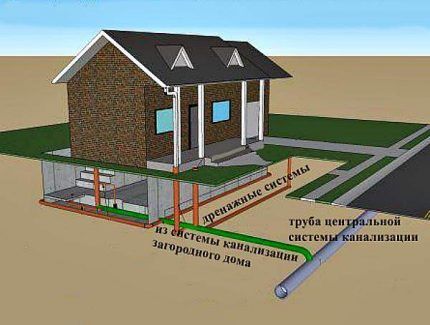
The issue of ventilation of sewer networks is considered, as a rule, in relation to internal communications. This includes all drain lines installed directly inside buildings.
At the same time, based on the classification of collected wastewater, sewer systems are divided into three types:
- household (household-fecal);
- rain (stormwater);
- production (industrial).
Household utility and fecal communications, in turn, are divided into centralized and autonomous systems. Many private house projects have been and are being carried out as an autonomous type.
True, at the present stage of construction of private residential real estate, its owners are increasingly trying to connect their home sewerage system to centralized lines. We recommend that you read all local sewerage schemes country house, popular among users.
Internal household communications traditionally contain the following plumbing fixtures:
- sinks and bathtubs;
- toilets, urinals and bidets;
- shower cabins.
This entire set is united by a pipeline system, which also includes ventilation risers, manifolds, connections, check valves and other components designed to ensure full functionality of the internal sewage system.
Why is sewer ventilation needed?
According to existing construction standards, low-rise (up to 2 floors) private real estate is allowed to be operated without equipping the sewerage system with a drain pipe.
This admission is due to the small number of people (consumers) living in small private houses, and therefore the relatively low load on the plumbing main.
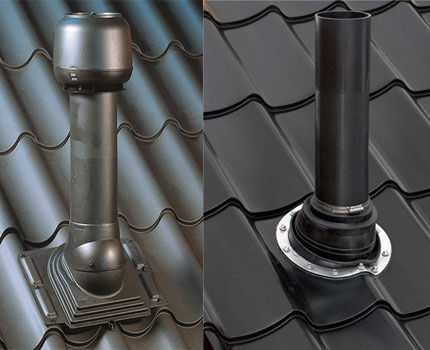
A drain pipe is a structure assembled from standard plumbing pipes and installed as a vertical riser with access to a level above the roof horizon. The purpose of such a structure is to create a connection (ventilation) between the internal atmosphere of sewer lines and the atmosphere of the external environment.
Thanks to this connection, the pressure difference that occurs during the process of draining a large mass of wastewater is compensated. In addition, the ventilation riser eliminates the formation of gas stagnation in the line.
The need to remove the ventilation riser becomes obvious if calculations show that simultaneous drainage from several plumbing fixtures can block the cross-section of the main sewer pipe.
This situation leads to the “breakdown” of hydraulic valves (carrying away water from the siphons of sinks, bathtubs, etc.). As a result, unpleasant odors begin to penetrate into the room through the vacated space.
True, to restore water seals, it is enough to turn on the flow of water on plumbing fixtures for a short time.
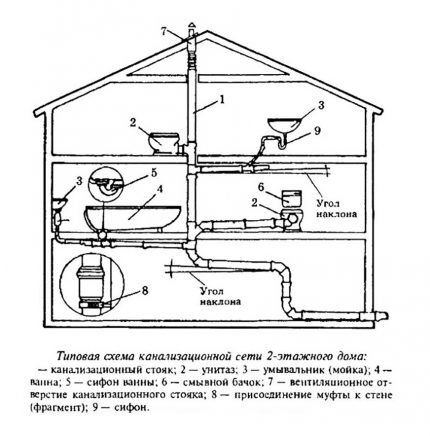
The communications of a small private house are usually not threatened by such a development of events. However, it is recommended not to abandon the construction of sewer ventilation for greater reliability and peace of mind for personal comfort.
The introduction of a drain pipe into the sewerage system eliminates the “breakdown” of hydraulic valves, ensures a balance of air flows and ventilation inside the communications.
Mandatory use of a ventilation riser:
- in private houses there are more than two floors with toilets and baths on each floor;
- when the cross-sectional size of pipelines, bends and risers of the sewer line is less than 50 mm;
- The house design provides for the installation of a septic tank in the adjacent area.
If the house design involves placing a swimming pool connected to a general sewer system, you will also have to take care of installing a riser.
Schemes for creating effective ventilation
Let's consider the main options for arranging effective ventilation of the sewer system in private households.
Option #1 - installation of a drain pipe
The efficiency of ventilation of the sewerage system is ensured by compliance with two main principles for installing a drain pipe. The first principle is based on the difference in diameters of the outlet and main pipes.
The diameter of the drain pipe should always be equal to or slightly larger than the diameter of the outlet from the main sewer line.
The second principle is to bring out and install the outlet of the upper end of the ventilation pipeline into an area of free air flow.
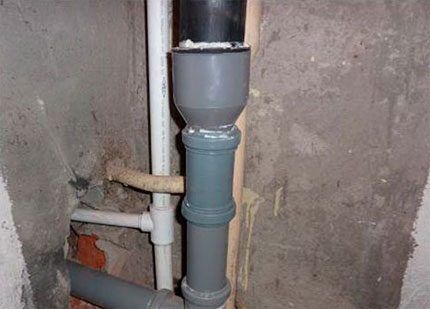
Installation of the ventilation riser is traditionally carried out using standard plastic pipes with a diameter of 110 mm. In addition to plastic, cast iron pipes are also used to assemble the fan line. But this construction option is usually the prerogative of large projects.
The pipes are connected one to another using rubber seals. Attach the ventilation line to the wall of the house using metal clamps, placing them on the surface of the pipes through rubber gaskets.
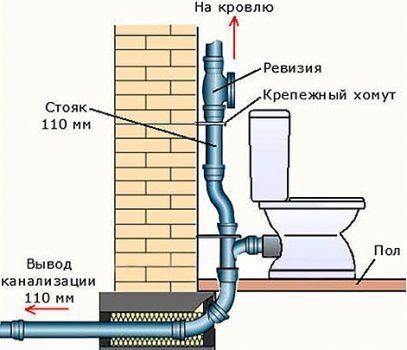
The top point of the ventilation pipe brought out must be at least 300 - 700 mm above the roofing horizon. These values are recommended for installation on houses with flat roofs or where the roof is made at a slight slope. The steeper the roof slope, the higher the height of the end part of the ventilation pipe.
Building codes also require maintaining a height distance from the top of closely spaced windows to the top of the drain pipe.
Here it is recommended to adhere to parameters no less than values equal to 3.5 - 4 m. Ventilation of the home sewage system is installed as a separate communications unit.
The rules (SNiP) do not allow the combination of sewer ventilation lines with other technical systems (chimneys, air hoods, etc.).
When developing a project for constructing ventilation for an independent sewer system in a country house, the following requirements must be taken into account:
We have detailed instructions on our website with step-by-step photos. installation of a drain pipe.
Option #2 - fan pipe + end pipe
For private house projects, it is sometimes permissible to implement a sewer ventilation riser installation scheme in which the upper section of the pipeline remains in the attic area.
But in this option, the attic must have the design of an actively ventilated room, which is rare for private housing construction projects. Therefore, the scheme with pulling the sewer ventilation pipe through the roof of the building remains relevant.
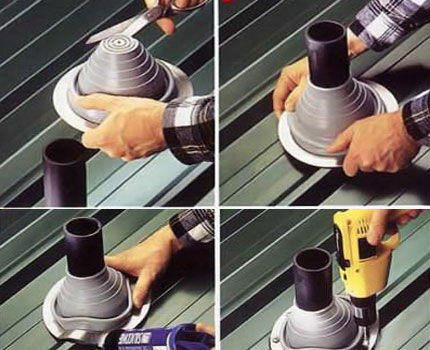
Output through the roof is usually implemented according to the following plan:
- The ventilation riser ends in the attic.
- An end pipe is installed on the roof.
- Connect the upper section of the riser with the lower section of the end switch using corrugation.
Installation of the end pipe on the roof is convenient and simple using an elastic polymer adapter. This strong, durable element has a round shape (there are also square ones), and due to the stepwise change in the diameters of the passage, it can be easily adjusted to a pipe of a specific cross-section.
You just need to cut off the excess part of the adapter material along the line of the required diameter.
An end pipe equipped with an adapter is inserted into a passage hole previously made in the calculated location of the roof covering. The lower cuff of the elastic adapter along the entire circumference of its junction is treated with sealant.
Next, using a metal flange and screws, the cuff is tightly fastened to the roof surface.
In order to enhance the efficiency of natural draft, an additional deflector.
A ventilation deflector is a device capable of increasing air draft due to the pronounced aerodynamic properties of the structure.The operating principle of such devices is based on the Bernoulli effect, when the speed of movement of air masses is directly proportional to the change in the cross section of the channel.
For sewer ventilation schemes in private houses, static (fixed) deflectors are often used. Less common, but also used rotational (rotating) deflectors.
This seemingly simple device plays a significant role in the operation of the ventilation system of the home sewage system. According to various estimates, the deflector gives an increase in traction by 20-30%.
Option #3 - sewer hood device
If the sewer outlet is not equipped with a water seal or the effect of the specified useful device is not enough, it is worth constructing and installing a sewer hood:
Option #4 - installing an aeration (vacuum) valve
The use of vacuum (aeration) valves as an alternative to a drain pipe should be considered a purely conditional phenomenon. Owners of private property can only use a scheme with vacuum valves if it is completely impossible to install a ventilation riser.
The low reliability of aeration valves is confirmed even by the absence of any information on these devices in the SNiP documentation.
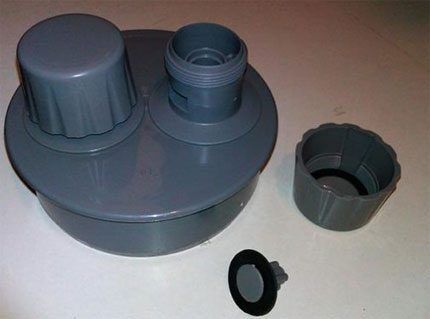
Vacuum valves are used exclusively on sewerage systems of private small-format houses.
The valve design is simple:
- plastic round body;
- there is a through hole in the body for the valve;
- membrane, rubber gasket.
The operating principle of the device is also simple.If a rarefied atmosphere (vacuum) is created in a sewer pipe due to an imbalance in pressure, the valve opens and air from the room is sucked into the pipe. As soon as the pressure in the pipe is equalized, the valve returns to its place.
If desired, the aeration mechanism can be made independently. But there are factory products on sale that have running sections of 50 and 110 mm. They are not cheap, but more reliable.
Aeration valves are usually installed in close proximity to plumbing risers at the highest points of the sewer system. Most often, the valve is installed on the upper outlet of the tee (cross), which is mounted on the outlet line from the toilet.
Owners of private houses who have chosen aeration valves will have to periodically engage in maintenance of these plumbing fixtures.
A certain period of operation of vacuum valves is accompanied by the accumulation of deposits and contaminants in the place where the valve seal is located.
The tightness of the device is broken, sewer odors begin to penetrate into the room. Therefore, maintenance must be carried out from time to time, and here is another plus in favor of the first ventilation scheme.
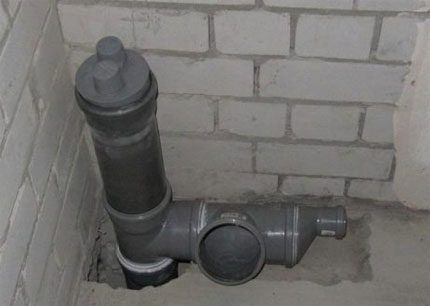
Another disadvantage of simplified valve ventilation of a household sewerage system is that it is only operational in positive temperature conditions.That is, if the aeration valve is installed in the area of possible temperature drop to zero degrees and below, there is a risk of system malfunction.
We have detailed instructions on our website installing a vacuum valve to the sewer.
Option #5 - external sewage ventilation device
Information about external ventilation schemes for the sewerage system of private houses is often found. The principle of constructing external ventilation is almost the same as in the case of the internal circuit.
The ventilation riser is mounted against the wall of the house and rises above the roof. Meanwhile, SNiP does not provide any recommendations in this regard.
On the contrary, the documentation clearly states that drain risers for ventilation of domestic sewage systems must be constructed inside heated premises.
Assembling a homemade fan pipe deflector
It is not necessary to buy a ventilation deflector. It is quite possible to make this traction pumping mechanism yourself.
From the set of tools and materials you will need the following:
- galvanized metal sheet;
- fasteners (small bolts with nuts or rivets);
- metal scissors;
- pencil, ruler.
The first step is to mark the lower part of the device - a cone-shaped bell. At the bottom, its diameter size should correspond to the diameter of the ventilation riser, and the diameter size of the upper part is increased by 10-15% of the lower size.
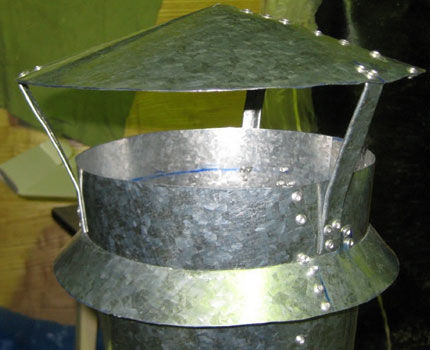
The resulting cone is fastened with bolts or rivets, and a “skirt” is placed in the middle part, cutting off part of the air flow. An umbrella is attached to the top of the stands.
Conclusions and useful video on the topic
You can learn more about the placement and significance of the fan riser from the following video:
A comfortable environment in the house is the main factor encouraging us to recommend that owners of private residential buildings pay attention to standard sewer ventilation technology.
It is up to the homeowners to decide whether to use this method or be content with a simplified ventilation scheme. Extra construction plans cost a pretty penny. True, you always have to pay for comfort.
Are you thinking about installing a ventilation riser for your home's sewer system? Maybe you still have unanswered questions after reading our article? Ask for advice - our engineer will try to help you.
Or are you already using simple sewer ventilation that you installed yourself? Tell us what scheme you used, what difficulties you encountered during the design and whether you are satisfied with the efficiency of the riser - leave your comments and add photos in the block below this article.




Hello, I am currently carrying out work on installing water supply and sewerage in a very old apartment building on the top floor, in which there is a drain. The risers are already made of plastic with a diameter of 110 mm, but there is no provision for an extended riser. There is no access to the roof.
The question is:
1. If you make a breath, then how important is it to make it from 110 pipes, why can’t I make it from 50?
2.What if the end of the exhaust pipe is made flush with the outer wall, covering it with a Vent grill to prevent precipitation from getting inside the pipe?